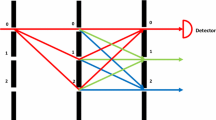Abstract
Recently, Long proposed a new type of quantum computers called duality computers or duality quantum computers. The duality computers based on the general quantum interference principle are much more powerful than an ordinary quantum computer. A mathematical theory for the duality computers has been presented by Gudder. However, he pointed out that a paradoxical situation of the mathematical theory occurs between the mixed state formalism and the pure state formalism. This paper argues for Gudder’s mathematical theory of the duality computers for the mixed state formalism. First, we point out two problems existing in the pure state description of the duality computers. Then, we present a new mathematical theory of the duality computers for the pure state formalism according with Gudder’s mixed state description, generalize the new mathematical theory of the duality computers in the density matrix formalism, and discuss some basic properties of the divider operators and combiner operators of the duality computers. The new mathematical theory can conquer the two problems mentioned above. Finally, we find that the nonunitary operations can be performed on every path of a quantum wave divider of the duality computers. Especially, we discuss in detail that the subwaves interact with environment by a CNOT gate.
Similar content being viewed by others
References
Long G.L.: The general quantum interference principle and the duality computer. Commun. Theor. Phys. 45, 825–844 (2006)
Long G.L., Liu Y.: Duality quantum computing. Front. Comput. Sci. China 2(2), 167–178 (2008)
Gudder S.: Mathematical theory of duality quantum computers. Quantum Inf. Proc. 6(1), 37–48 (2007)
Long G.L.: Mathematical theory of the duality computer in the density matrix formalism. Quantum Inf. Proc. 6(1), 49–54 (2007)
Gudder S.: Duality quantum computers and quantum operations. Int. J. Theor. Phys. 47, 268–279 (2008)
Du H.-K., Wang Y.-Q., Xu J.-L.: Applications of the generalized Lüders theorem. J. Math. Phys. 49(1), 013507 (2008)
Wang Y.-Q., Du H.-K., Dou Y.-N.: Note on generalized quantum gates and quantum operations. Int. J. Theor. Phys. 47, 2268–2278 (2008)
Long, G.L., Liu, Y.: Duality and recycling computing in quantum computers. arXiv: quant-ph/0708.1986 (2007)
Wang W.Y., Shang B., Wang C., Long G.L.: Prime factorization in the duality computer. Commun. Theor. Phys. 47, 471–473 (2007)
Shang, B.: A summary on two new algorithms for Grover’s unsorted database search problem. arXiv: quant-ph/0603210v2 (2006)
Shang B.: Quantum query complexity for searching multiple marked states from an unsorted database. Commun. Theor. Phys. 48, 264–266 (2007)
Author information
Authors and Affiliations
Corresponding author
Rights and permissions
About this article
Cite this article
Zou, X., Qiu, D., Wu, L. et al. On mathematical theory of the duality computers. Quantum Inf Process 8, 37–50 (2009). https://doi.org/10.1007/s11128-008-0093-6
Received:
Accepted:
Published:
Issue Date:
DOI: https://doi.org/10.1007/s11128-008-0093-6




